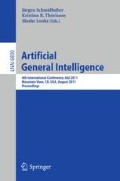Abstract
Extraordinary structural organization known as emergence is observed in partially ordered sets when a recently discovered functional is minimized. Emergence creates the first structures, and feedback reuses them to create hierarchies of structures. The partially ordered set is the knowledge representation, the functional connects local behavior to global phenomena, emergence and feedback correspond to inference, and the structures and hierarchies to objects and inheritance hierarchies. If intelligence includes the ability to solve problems, then the structures represent intelligence and emergence represents the build up of intelligence. Since the structures are mathematically obtained from first principles, the finding is proposed as an explanation for the origin of intelligence, and the functional as the key for AGI. Three previous computer experiments, and another one reported here, duplicate higher functions of the human brain and confirm the findings.
Access this chapter
Tax calculation will be finalised at checkout
Purchases are for personal use only
Preview
Unable to display preview. Download preview PDF.
References
Cooper, S.B.: Emergence as a computability-theoretic phenomenon. Applied Math. and Computation 215, 1351–1360 (2009)
Prokopenko, M., Boschetti, F., Ryan, A.J.: An Information-Theoretic Primer on Complexity, Self-Organization, and Emergence. Complexity 15, 11–28 (2009)
Opdyke, W.F.: Refactoring object-oriented frameworks. Ph.D. thesis, Dep. Comp. Science, Univ. of Illinois, Urbana-Champaign (1992)
Garrido, A., Johnson, R.: Challenges of refactoring C programs. In: Proc. International Workshop on Principles of Software Evolution, Orlando, Florida, pp. 6–14 (2002)
Wilson, G.: Refactoring the law: reformulating legal ontologies. Juris Dr. Writing Requirement, School of Law, Univ. of San Francisco (2006)
Ambler, S.J., Sadalage, P.J.: Refactoring Databases: Evolutionary Database Design. Addison-Wesley, Reading (2011)
Chan, L.Y., Kosuri, S., Endy, D.: Refactoring bacteriophage T7. Molecular Systems Biology, article number: 2005.0018 (September 13, 2005)
Pissanetzky, S.: A Relational Virtual Machine for Program Evolution. In: Proc. 2007 Int. Conf. on Software Engng. Research and Practice, vol. I, pp. 144–150 (2007)
Pissanetzky, S.: Sparse Matrix Technology. Academic Press, London (1984)
Pissanetzky, S.: The matrix model of computation. In: Proc. 12th. WMSCI Conf. vol. IV, pp. 184–189 (2008)
Pissanetzky, S.: Applications of the Matrix Model of Computation. In: Proc. 12th. WMSCI Conference, vol. IV, pp. 190–195 (2008)
Pissanetzky, S.: A new Type of Structured Artificial Neural Networks based on the Matrix Model of Computation. In: Arabnia, H.R., Mun, Y. (eds.) The 2008 International Conference on Artificial Intelligence, vol. I, pp. 251–257 (2008)
Pissanetzky, S.: A new Universal Model of Computation and its Contribution to Learning, Intelligence, Parallelism, Ontologies, Refactoring, and the Sharing of Resources. Int. J. of Information and Mathematical Sciences 5, 143–173 (2009)
Pissanetzky, S.: Coupled Dynamics in Host-Guest Complex Systems Duplicates Emergent Behavior in the Brain. World Academy of Science, Engineering and Technology 68, 1–9 (2010)
Lina, L., Osana, R., Tsiena, J.Z.: Organizing principles of real-time memory encoding: neural clique assemblies and universal neural codes. Trends in Neurosciences 29, 48–57 (2006)
Author information
Authors and Affiliations
Editor information
Editors and Affiliations
Rights and permissions
Copyright information
© 2011 Springer-Verlag Berlin Heidelberg
About this paper
Cite this paper
Pissanetzky, S. (2011). Structural Emergence in Partially Ordered Sets Is the Key to Intelligence. In: Schmidhuber, J., Thórisson, K.R., Looks, M. (eds) Artificial General Intelligence. AGI 2011. Lecture Notes in Computer Science(), vol 6830. Springer, Berlin, Heidelberg. https://doi.org/10.1007/978-3-642-22887-2_10
Download citation
DOI: https://doi.org/10.1007/978-3-642-22887-2_10
Publisher Name: Springer, Berlin, Heidelberg
Print ISBN: 978-3-642-22886-5
Online ISBN: 978-3-642-22887-2
eBook Packages: Computer ScienceComputer Science (R0)

